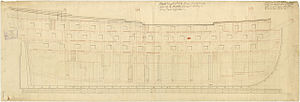
HMS Bellona was a 74-gun Bellona-class third-rate ship of the line of the Royal Navy. Designed by Sir Thomas Slade, she was a prototype for the iconic 74-gun ships of the latter part of the 18th century. "The design of the Bellona class was never repeated precisely, but Slade experimented slightly with the lines, and the Arrogant, Ramillies, Egmont, and Elizabeth classes were almost identical in size, layout, and structure, and had only slight variations in the shape of the underwater hull. The Culloden-class ship of the line was also similar, but slightly larger. Thus over forty ships were near-sisters of the Bellona." Bellona was built at Chatham, starting on 10 May 1758, launched on 19 February 1760, and commissioned three days later. She was the second ship of the Royal Navy to bear the name, and saw service in the Seven Years' War, American Revolutionary War and the Napoleonic Wars.

Royal Charles was an 80-gun first-rate three-decker ship of the line of the English Navy. She was built by Peter Pett and launched at Woolwich Dockyard in 1655, for the navy of the Commonwealth of England. She was originally called Naseby, named in honour of Sir Thomas Fairfax's decisive 1645 victory over the Royalist forces during the English Civil Wars. She was ordered in 1654 as one of a programme of four second rates, intended to carry 60 guns each. However, she was altered during construction to mount a complete battery of guns along the upper deck, and so was reclassed as a first rate.
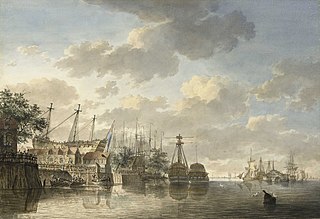
HMS Queen was a three-deck 90-gun second-rate ship of the line of the Royal Navy, launched on 18 September 1769 at Woolwich Dockyard. She was designed by William Bateley, and was the only ship built to her draught. Her armament was increased to 98 guns in the 1780s.
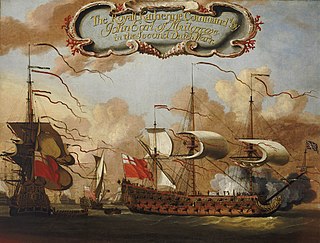
HMS Royal Katherine was an 84-gun full-rigged second-rate ship of the line of the Royal Navy, launched in 1664 at Woolwich Dockyard. Her launching was conducted by Charles II and attended by Samuel Pepys. Royal Katherine fought in both the Second and Third Anglo-Dutch Wars and afterwards, the War of the Grand Alliance before entering the dockyard at Portsmouth for rebuilding in 1702. In this rebuilding, she was upgraded to carry more guns, 90 in total, and served in the War of the Spanish Succession during which she was renamed Ramillies in honour of John Churchill's victory at the Battle of Ramillies. She was rebuilt again in 1742–3 before serving as the flagship of the ill-fated Admiral John Byng in the Seven Years' War. Ramillies was wrecked at Bolt Tail near Hope Cove on 15 February 1760.
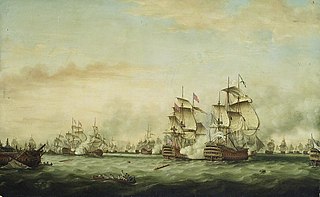
HMS Barfleur was a 90-gun second-rate ship of the line of the Royal Navy, designed by Sir Thomas Slade on the lines of the 100-gun ship Royal William, and launched at Chatham Dockyard on 30 July 1768, at a cost of £49,222. In about 1780, she had another eight guns added to her quarterdeck, making her a 98-gun ship; she possessed a crew of approximately 750. Her design class sisters were the Prince George, Princess Royal, and Formidable. She was a ship of long service and many battles.

HMS Royal Oak was a 74-gun third-rate ship of the line of the Royal Navy, built by Jonas Shish at Deptford and launched in 1674. She was one of only three Royal Navy ships to be equipped with the Rupertinoe naval gun. Life aboard her when cruising in the Mediterranean Sea in 1679 is described in the diary of Henry Teonge.
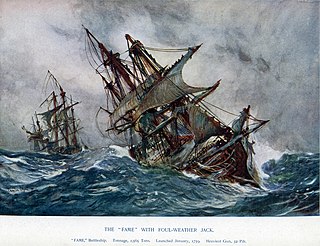
HMS Fame was a 74-gun third-rate ship of the line of the Royal Navy, in service during the Seven Years' War and the American Revolutionary War.

HMS Majestic was a 74-gun third-rate ship of the line launched on 11 December 1785 at Deptford.

HMS Illustrious was a 74-gun third rate ship of the line of the Royal Navy, launched on 7 July 1789 at Bucklers Hard under the direction of Henry Adams. She participated in the Battle of Genoa after which she was wrecked.

HMS London was a 90-gun second-rate ship of the line of the Royal Navy, launched on 24 May 1766 at Chatham Dockyard.
HMS Russell was a 74-gun third rate ship of the line of the Royal Navy, launched on 10 November 1764 at Deptford.

HMS Venerable was a 74-gun third-rate ship of the line of the Royal Navy, launched on 19 April 1784 at Blackwall Yard.

HMS Caesar, also Cæsar, was an 80-gun third rate ship of the line of the Royal Navy, launched on 16 November 1793 at Plymouth. She was designed by Sir Edward Hunt, and was the only ship built to her draught. She was also one of only two British-built 80-gun ships of the period, the other being HMS Foudroyant.

HMS Dragon was a 74-gun third rate ship of the line of the Royal Navy, launched on 2 April 1798 at Rotherhithe. She was designed by Sir William Rule, and was the only ship built to her draught.
Laurel was a 48-gun fourth-rate of the navy of the Commonwealth of England. She participated in almost all major Fleet Actions of the First Anglo-Dutch War. She was an active participant in the battles of Kentish Knock, Dungeness, Portland, The Gabbard and Scheveningen. She went to the west Indies with Admiral William Penn. She was wrecked in May 1657.
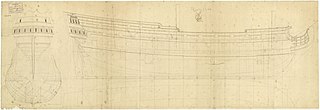
HMS Kingston was a 60-gun fourth-rate ship of the line of the Royal Navy, built by Frame in Hull and launched on 13 March 1697. She had an eventful career, taking part in numerous engagements.
HMS Ranelagh was a three-decker 80-gun third-rate ship of the line of the Royal Navy, launched at Deptford Dockyard on 25 June 1697. She took part in a number of actions during the War of the Spanish Succession, including the Battle of Vigo in 1702 and the Battle of Vélez-Málaga in 1704.

HMS Orford was a 70-gun third-rate ship of the line of the Royal Navy, launched at Deptford in 1698. She carried twenty-two 24-pounder guns and four (18-pounder) culverins on the lower deck; twenty-six 12-pounder guns on the upper deck; fourteen (5-pounder) sakers on the quarter-deck and forecastle; and four 3-pounder guns on the poop or roundhouse.
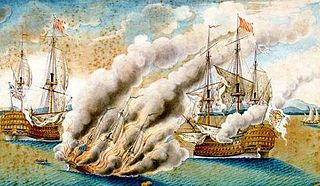
HMS Namur was a 90-gun second rate ship of the line of the Royal Navy, launched at Woolwich Dockyard in 1697.

HMS Victor Emmanuel was a screw-propelled 91-gun second-rate ship of the line of the Royal Navy, originally launched as HMS Repulse, but renamed shortly after being launched.
